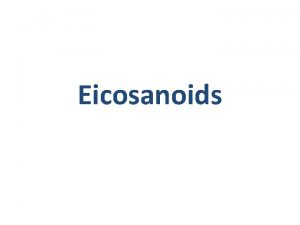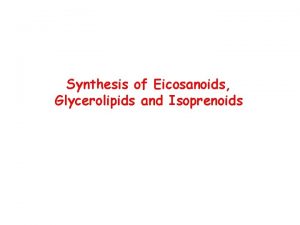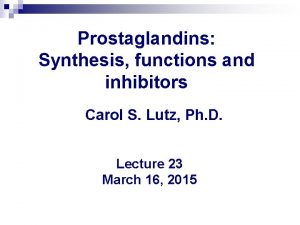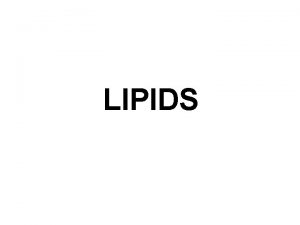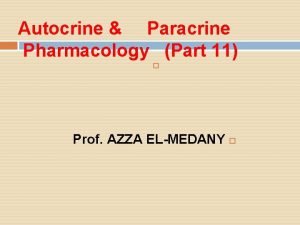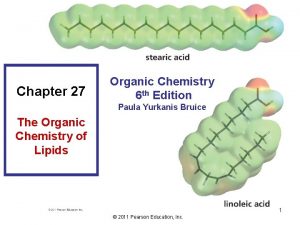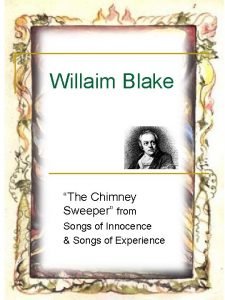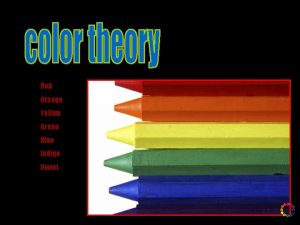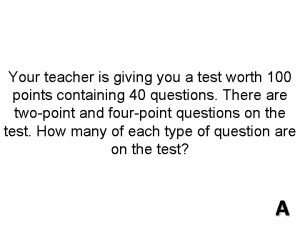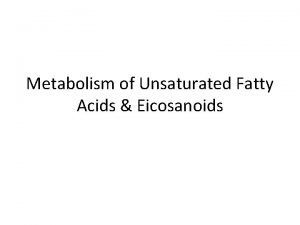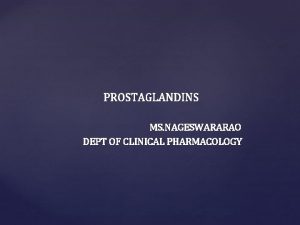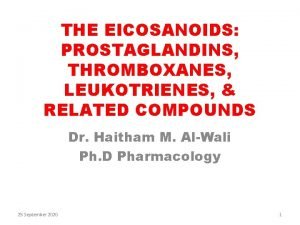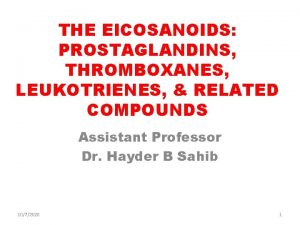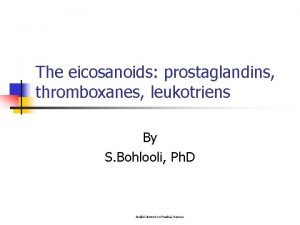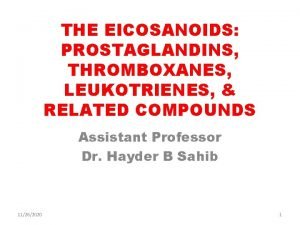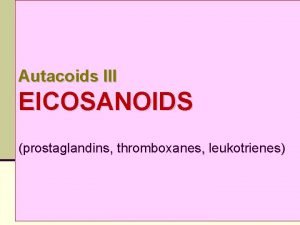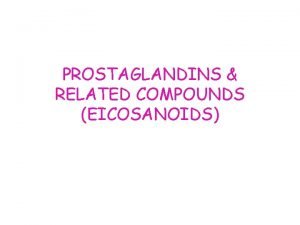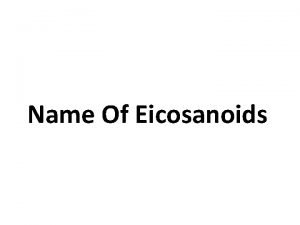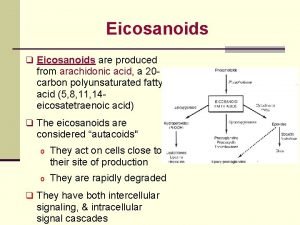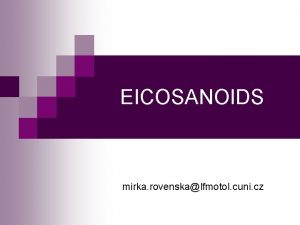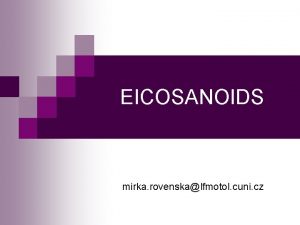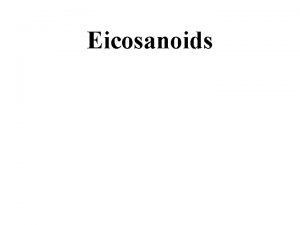Eicosanoids Prostaglandins and leucotreines Eicosanoids Prostaglandins and leucotreines



![EP 4 (PGE 2) AC , [c. AMP] Small intestine, lung, thymus, kidney, uterus, EP 4 (PGE 2) AC , [c. AMP] Small intestine, lung, thymus, kidney, uterus,](https://slidetodoc.com/presentation_image_h2/4e4cb8a677559b285543e8f7b22d8b64/image-4.jpg)











- Slides: 15

Eicosanoids Prostaglandins and leucotreines

Eicosanoids Prostaglandins and leucotreines Derivatives of the naturally occurring polyunsaturated 20 -carbon fatty acid Arachidonic acid Important mediators of inflammation Have essential physiological actions Their effects are believed to be receptor mediated

Prostaglandin Receptors http: //www. caymanchem. com/app/template/scientific. Illustrations%2 CIllustration. vm/illustration/2018/a/z
![EP 4 PGE 2 AC c AMP Small intestine lung thymus kidney uterus EP 4 (PGE 2) AC , [c. AMP] Small intestine, lung, thymus, kidney, uterus,](https://slidetodoc.com/presentation_image_h2/4e4cb8a677559b285543e8f7b22d8b64/image-4.jpg)
EP 4 (PGE 2) AC , [c. AMP] Small intestine, lung, thymus, kidney, uterus, pancreas, spleen, heart, stomach, brain, ileum, peripheral blood mononuclear cells FP (PGF 2) phosphoinositol turnover , [Ca 2+] Corpus luteum, uterus, stomach, kidney, heart, lung, eye, liver IP (PGI 2) AC , [c. AMP] Platelets, VSM, kidney, thymus, liver, lung, spleen, skeletal muscle, heart, pancreas TP (TXA 2) phosphoinositol turnover , [Ca 2+] Platelets, VSM, thymus, spleen,

n Synthesis: Cell membrane phospholipids NSAIDS Phospholipase A 2 Arachidonic acid Lipoxygenase Cyclooxygenase ( PG synthase ) 5 -HPESE PGD, PGH 2, PGG 2 v p LTB 4, LTC 4, LTD 4 ( SRS-A ) TXA 2 PGE 2 PGF 2α PGE 1 PGI 2

PG’s are involved in: - Inflammatory reactions - Platelet aggregation - Control of B. P ( diameter of blood vessels ) - Contraction of the uterus - Protection of the stomach and duodenum…etc n

Leukotreines are involved in: - Inflammatory reactions - Allergic reactions SRS-A ( slow reacting substance of anaphylaxis ) Believed to be a mixture of LTB 4, LTC 4, LTD 4 and is responsible for the severe bronchoconstriction in patients with anaphylaxis or bronchial asthma n

Lipooxygenase: Lungs, W. B. C’s, Platelets Cyclooxygenase ( COX ): All tissues COX 1: Stomach, Kidneys, Platelets COX 2: Other tissues Prostacyclin synthase: Blood vessels Thromboxane synthase: Platelets

n PG’s MOA: Receptor mediated PG ’s Thromboxane Prostacyclin synthase Synthase TXA 2 - PGI 2 + Adenylate cyclase Phosphodiesterase Degradation c. AMP

Inhibitors of PG synthesis: - Phospholipase A 2 inhibitors n Glucocorticoids Phenothiazines Local anesthetics Antimalarial agents

- Cyclooxygenase inhibitors * Nonselective: Block COX 1 & COX 2 NSAIDs ( Aspirin, Ibuprofen, Indomethacin, Piroxicam, Diclofenac Na+ K+, Mefenamic acid, Sulfenpyrazone, Phenybutazone, Sulindac. . etc ) * Selective: Block only COX 2 Meloxicam, Rofecoxib, Etoricoxib; Etodolac, Valdecoxib; Nabumetone…etc

- Thromboxane synthase inhibitors Dazoxiben, Hydralazine - Antagonists and inhibitors of leukotrienes synthesis: Given orally to patients with bronchial asthma and have potential use in allergy *Lipoxygenase inhibitors Zileuton *Leukotrienes antagonists Zafirlukast, Montelukast…

Major pharmacological effects to PGs: - CVS: E, I 2 → vasodilatation → ↓ B. P TXA 2 → vasoconstriction - Blood: E 1, I 2 ( prostacyclin ) → ↓ platelet aggregation TXA 2 → ↑ platelet aggregation - Bronchi: I 2, E → dilatation F → constriction - Uterus: E, F 2α strong contractors - Stomach: E, A, I 2 ↓ acid ↑ mucus n

Available PG’s, their clinical uses and dosage forms ( adm. ): - Abortifacient, labor inducers: Gemeprost ( E 1 ) vaginal pessaries Dinoprostone ( E 2 ) oral, vag. Tab. , I. V infusion Dinoprost ( F 2α ) oral, I. V infusion, intrauterine, intracervical, intraamniotic - Peptic ulcer disease Misoprostol ( E 1 ) oral n

- Antiplatelet, peripheral vascular disease, Raynaud’s disease Epoprostenol ( I 2 ), Iloprost ( I 2 ) I. V infusion - Keeping patent ductus arteriosus, impotency Alprostadil ( PGE 1 ) I. V infusion, injection into penis ( I. V ) & urethral suppositories - Postpartum hemorrhage Carboprost ( F 2α ) I. M
 Function of eicosanoids
Function of eicosanoids Eicosanoid synthesis
Eicosanoid synthesis Prostaglandins synthesized from
Prostaglandins synthesized from Why are lipids insoluble in water
Why are lipids insoluble in water Prostaglandins classification
Prostaglandins classification Terpenes steroids prostaglandins
Terpenes steroids prostaglandins Purple yellow red and blue
Purple yellow red and blue Willaim blake
Willaim blake West side story romeo and juliet comparison
West side story romeo and juliet comparison Taller and younger shorter and older
Taller and younger shorter and older 75 centavos in symbol
75 centavos in symbol Red orange yellow green blue indigo violet
Red orange yellow green blue indigo violet Your teacher is giving you a test worth 100 points
Your teacher is giving you a test worth 100 points Young and dyslexic poem
Young and dyslexic poem Compare and contrast maynard jackson and andrew young
Compare and contrast maynard jackson and andrew young West yorkshire health and care partnership
West yorkshire health and care partnership
